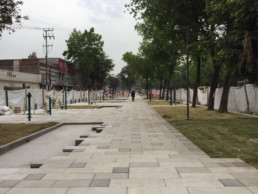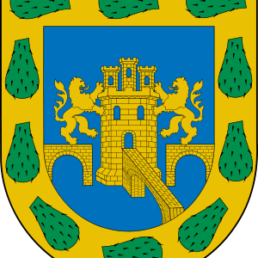With the construction of Parque Lineal La, Mexico City is preventing floods, reducing heatwaves, and increasing potable water, as well as providing new business opportunities for locals.
Spreading across almost 16,500 m2, Parque Lineal La Viga was constructed in the eastern part of Mexico City in 2015, mitigating urban climate vulnerabilities such as floods, water shortages, and heatwaves, in addition to preventing unequal urban development in an underprivileged part of the city. Up to 60% of the park’s area serves as a rain water catchment surface, mitigating floods by relieving pressure from the drainage and sewage systems. The collected stormwater is then treated and can be used as potable water, diversifying the city’s water sources.

Nearly 500 neighbors participated in the design of the park, aiming to create a major attraction to encourage social cohesion and economic development. Reachable by up to 4.6 million people within 30 minutes on public transport, the city anticipates that the presence of the park will result in increased revenues by local businesses and demonstrate the critical role of accessible public spaces in cities.
30,000 people are able to reach the park by foot
The challenge
The effects of climate change, such as cyclical floods, water shortages, and heatwaves are some of the most pressing urban vulnerabilities in Mexico City, and the most disadvantaged communities are most at risk. The Parque Lineal La Viga sets an example of how investment in public spaces that integrate resource management infrastructures is not a lifestyle amenity, but a strategic city action, mitigating urban climate vulnerabilities while opening up opportunities for economic development.
Co-benefits
Economic Due to the success of the Parque Lineal La Viga, Mexico City’s Authority for Public Space plans to invest in a new park twice its size, in one of the most densely populated and marginalized boroughs, Iztapalapa.
Environmental In an attempt to raise the available green space per inhabitant from 5 m2 to 10 m2, as suggested by the World Health Organization, there will be 22% more green areas and up to 100 new trees in the park.
Health The park’s design has allocated areas for sports and exercise, including a multi-use forum, which can be used for activities such as dance and yoga.
Social The accessibility of the park will encourage interactions between people of all ages and gender, improving social cohesion in the area.
About Mexico City
Mexico City is the capital and most populous city of Mexico. Mexico City is one of the most important financial centers in the Americas. According to the most recent definition agreed upon by the federal and state governments, the Greater Mexico City population is 21.3 million people, making it the largest metropolitan area of the Western Hemisphere. In recent years, the local government has passed a wave of liberal policies, such as abortion on request, a limited form of euthanasia, no-fault divorce, and same-sex marriage.


